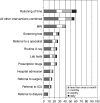Prevalence and determinants of physician bedside rationing: data from Europe
- PMID: 16836629
- PMCID: PMC1831659
- DOI: 10.1111/j.1525-1497.2006.00551.x
Prevalence and determinants of physician bedside rationing: data from Europe
Abstract
Background: Bedside rationing by physicians is controversial. The debate, however, is clouded by lack of information regarding the extent and character of bedside rationing.
Design, setting, and participants: We developed a survey instrument to examine the frequency, criteria, and strategies used for bedside rationing. Content validity was assessed through expert assessment and scales were tested for internal consistency. The questionnaire was translated and administered to General Internists in Norway, Switzerland, Italy, and the United Kingdom. Logistic regression was used to identify the variables associated with reported rationing.
Results: Survey respondents (N=656, response rate 43%) ranged in age from 28 to 82, and averaged 25 years in practice. Most respondents (82.3%) showed some degree of agreement with rationing, and 56.3% reported that they did ration interventions. The most frequently mentioned criteria for rationing were a small expected benefit (82.3%), low chances of success (79.8%), an intervention intended to prolong life when quality of life is low (70.6%), and a patient over 85 years of age (70%). The frequency of rationing by clinicians was positively correlated with perceived scarcity of resources (odds ratio [OR]=1.11, 95% confidence interval [CI] 1.06 to 1.16), perceived pressure to ration (OR=2.14, 95% CI 1.52 to 3.01), and agreement with rationing (OR=1.13, 95% CI 1.05 to 1.23).
Conclusion: Bedside rationing is prevalent in all surveyed European countries and varies with physician attitudes and resource availability. The prevalence of physician bedside rationing, which presents physicians with difficult moral dilemmas, highlights the importance of discussions regarding how to ration care in the most ethically justifiable manner.
Figures
Comment in
-
Tough questions, even harder answers.J Gen Intern Med. 2006 Nov;21(11):1209-10. doi: 10.1111/j.1525-1497.2006.00617.x. J Gen Intern Med. 2006. PMID: 17026736 Free PMC article. No abstract available.
Similar articles
-
Physicians' views on resource availability and equity in four European health care systems.BMC Health Serv Res. 2007 Aug 31;7:137. doi: 10.1186/1472-6963-7-137. BMC Health Serv Res. 2007. PMID: 17764556 Free PMC article.
-
A survey of Ethiopian physicians' experiences of bedside rationing: extensive resource scarcity, tough decisions and adverse consequences.BMC Health Serv Res. 2015 Oct 14;15:467. doi: 10.1186/s12913-015-1131-6. BMC Health Serv Res. 2015. PMID: 26467298 Free PMC article.
-
[Extent and impact of bedside rationing in German hospitals: results of a representative survey among physicians].Dtsch Med Wochenschr. 2009 Jun;134(24):1261-6. doi: 10.1055/s-0029-1225273. Epub 2009 Jun 4. Dtsch Med Wochenschr. 2009. PMID: 19499496 German.
-
Recognizing bedside rationing: clear cases and tough calls.Ann Intern Med. 1997 Jan 1;126(1):74-80. doi: 10.7326/0003-4819-126-1-199701010-00010. Ann Intern Med. 1997. PMID: 8992926 Review.
-
Visibility and the just allocation of health care: a study of age-rationing in the British National Health Service.Health Care Anal. 1993 Nov;1(2):139-50. doi: 10.1007/BF02197107. Health Care Anal. 1993. PMID: 10135591 Review.
Cited by
-
Rule of rescue or the good of the many? An analysis of physicians' and nurses' preferences for allocating ICU beds.Intensive Care Med. 2011 Jul;37(7):1210-7. doi: 10.1007/s00134-011-2257-6. Epub 2011 Jun 7. Intensive Care Med. 2011. PMID: 21647719
-
Self-Reported Rationing Behavior Among US Physicians: A National Survey.J Gen Intern Med. 2016 Dec;31(12):1444-1451. doi: 10.1007/s11606-016-3756-5. Epub 2016 Jul 19. J Gen Intern Med. 2016. PMID: 27435251 Free PMC article.
-
Ethical dilemmas in prioritizing patients for scarce radiotherapy resources.BMC Med Ethics. 2024 Jan 31;25(1):12. doi: 10.1186/s12910-024-01005-3. BMC Med Ethics. 2024. PMID: 38297294 Free PMC article.
-
The role of ethics committees and ethics consultation in allocation decisions: a 4-stage process.Med Care. 2010 Sep;48(9):821-6. doi: 10.1097/MLR.0b013e3181e577fb. Med Care. 2010. PMID: 20706163 Free PMC article.
-
Focus groups highlight that many patients object to clinicians' focusing on costs.Health Aff (Millwood). 2013 Feb;32(2):338-46. doi: 10.1377/hlthaff.2012.0686. Health Aff (Millwood). 2013. PMID: 23381527 Free PMC article.
References
-
- Asch DA, Ubel PA. Rationing by any other name. N Engl J Med. 1997;336:1668–71. - PubMed
-
- Relman A. Use of medical resources—overview. Prev Med. 1990;19:688–92. - PubMed
-
- Bloche MG, Jungman ER. The “R” word. J Contemp Health Law Policy. 2002;18:633–9. - PubMed
-
- Coulter A, Ham C. The Global Challenge of Health Care Rationing. Buckingham: Open University Press; 2000.
-
- Sulmasy DP. Physicians, cost control, and ethics. Ann Intern Med. 1992;116:920–6. - PubMed
Publication types
MeSH terms
LinkOut - more resources
Full Text Sources


